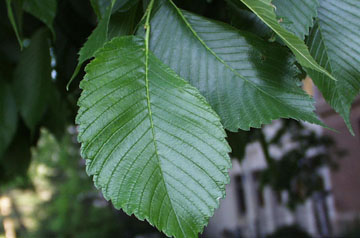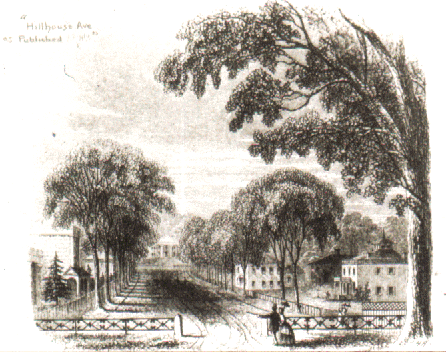New Haven, Connecticut
Fall 1759
The last remnants of an
autumn thunderstorm linger and sunrise lights the clouds of a
gray dawn marching off toward the distant sound of war.
"Wait Old Sachem !"
"Come along Jemmy,
the morning is wasting and we've trees to plant." James
Hillhouse stood patiently as his nephew caught up with him. He
sat a water bucket for his horse and carefully unloaded a tender
sapling from the wagon.
"Why aren't we planting
oak trees today Sachem ? I like the oak with its leafy scallops
and mighty trunk !"
"Ya ! I agree with
you most heartily. The oak is a fine tree sacred to the Scotland
of our ancestors. May I be the first to introduce you to this
fine young species ? Its lacy branches afford a hopeful promise
of this colony's bright future, a fitting symbol of this beautiful
land of America.
|
Look
here, he pointed reverently, its leaf reveals a tiny miniature
of the grand arches of gothic cathedrals. In your lifetime my
little one, this handsome branch will tower above us to spread
its green canopy of shade for your afternoon walk from school.
" |
 |
"Oh, such a handsome
cluster of leaves !"
They planted through the
cool morning sun, carefully fashioning a deep round hole in the
course Connecticut soil, throwing in manure to feed the young
roots, pouring buckets of water over to sink into the depths
and carefully spreading the young roots toward the four winds
just before they covered them with a blanket of soil.
A so it comes and goes
in a blink of the minds eye, a glimpse of a day in the childhood
of one of America's Founding fFathers.

Long before Johnny Appleseed
set foot in Ohio, New Haven, Connecticut had James Hillhouse
whose extensive elm-planting campaign transformed the city into
one of the most celebrated in 19th-century America.
American elms had been
planted in the city as early as 1685, but it was in 1759 that
Hillhouse planted the rows of trees around the market square.
The trees grew rapidly and may even have helped save the town
during the Revolutionary War.
According to legend, General
George Garth, commander of the British forces invading New Haven,
refrained from razing the town in July 1779 because he was so
moved by its sylvan beauty. 'It is too pretty to burn,' he reportedly
muttered, and led his men away.
from the book
Republic of Shade:
New England and the American Elm
by Thomas Campanella


Hillhouse Avenue
New Haven, Connecticut
19th century